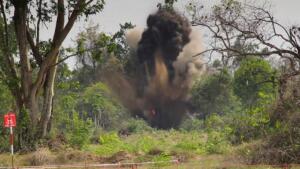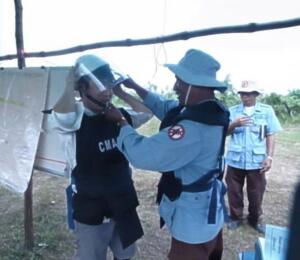


※ The image shows an anti-tank mine that has appeared near the surface, the detonation process, and my inspection.
In August of this year, there were two accidents in Battambang caused by anti-tank mines. In both cases, a man riding a tiller was damaged and killed instantly.
Unlike anti-personnel mines, which are buried just below the surface of the ground, anti-tank mines are placed about one meter below the surface. Since the objective is to destroy tanks, which are huge pieces of steel, they are not supposed to be detonated by anything more than a cultivator.
However, demining organizations point out that anti-tank mines are getting closer to the surface due to the movement of topsoil caused by wind and rain over the years and the development of farms.
What is important in demining is not the number of mines. What is important is the area that is guaranteed to be safe; if there are even a few mines in one hectare, the land is unusable. The key is how to increase the area of safe land. It is difficult to remove mines from land that is already in use.
The two accidents occurred on farmland. Last year, an accident involving an anti-tank mine that killed 13 people also occurred on a fruit farm.
Accidents continue to occur during the work of those who remove the mines. There are no mines made in Cambodia. All are silent weapons produced by various countries in the U.S.-Soviet East and West camps. At the current pace, this means that it will take 300 to 400 years.
Battambang is the world's worst mine-contaminated area. The negative legacy of the nearly forgotten proxy war between the U.S. and the Soviet Union during the Cold War. A battle with no end in sight continues on the ground.
